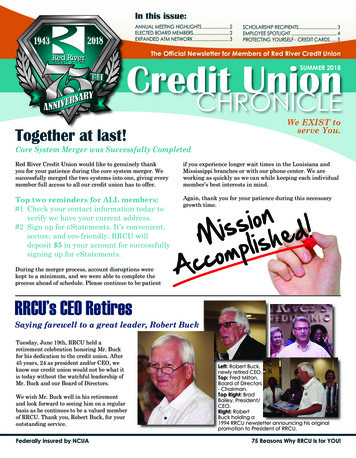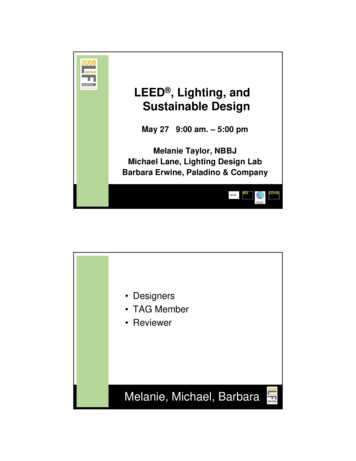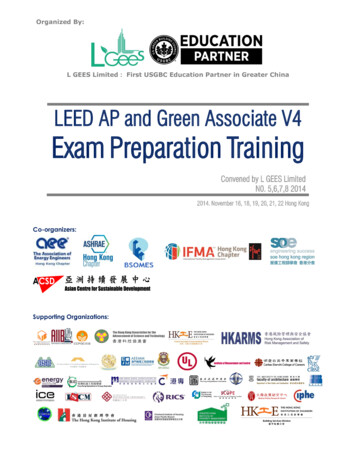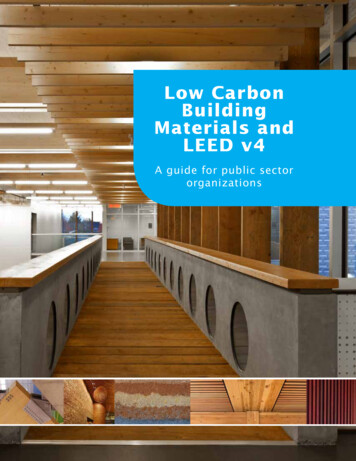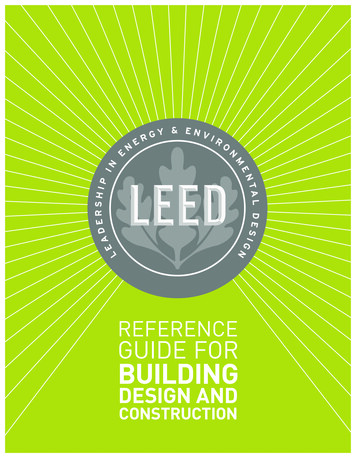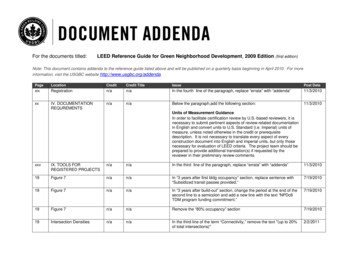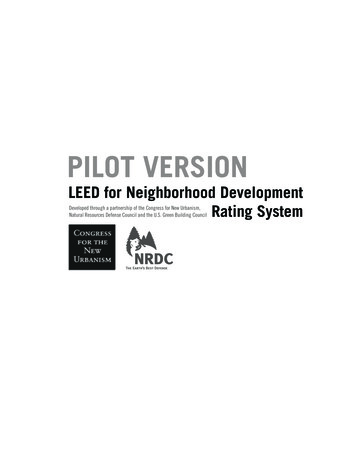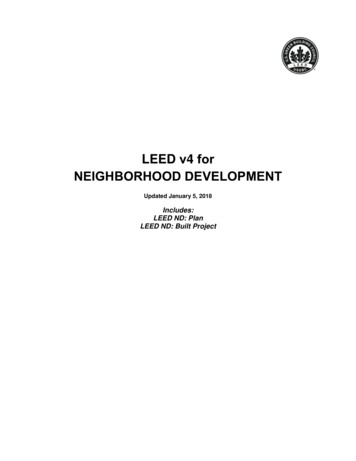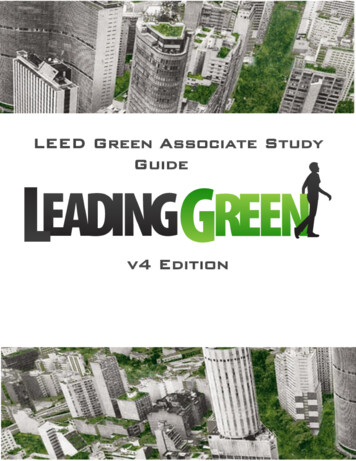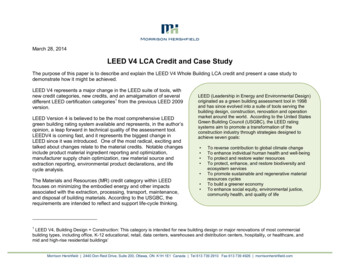
Transcription
March 28, 2014LEED V4 LCA Credit and Case StudyThe purpose of this paper is to describe and explain the LEED V4 Whole Building LCA credit and present a case study todemonstrate how it might be achieved.LEED V4 represents a major change in the LEED suite of tools, withnew credit categories, new credits, and an amalgamation of severaldifferent LEED certification categories1 from the previous LEED 2009version.LEED Version 4 is believed to be the most comprehensive LEEDgreen building rating system available and represents, in the author’sopinion, a leap forward in technical quality of the assessment tool.LEEDV4 is coming fast, and it represents the biggest change inLEED since it was introduced. One of the most radical, exciting andtalked about changes relate to the material credits. Notable changesinclude product material ingredient reporting and optimization,manufacturer supply chain optimization, raw material source andextraction reporting, environmental product declarations, and lifecycle analysis.The Materials and Resources (MR) credit category within LEEDfocuses on minimizing the embodied energy and other impactsassociated with the extraction, processing, transport, maintenance,and disposal of building materials. According to the USGBC, therequirements are intended to reflect and support life-cycle thinking.LEED (Leadership in Energy and Environmental Design)originated as a green building assessment tool in 1998and has since evolved into a suite of tools serving thebuilding design, construction, renovation and operationmarket around the world. According to the United StatesGreen Building Council (USGBC), the LEED ratingsystems aim to promote a transformation of theconstruction industry through strategies designed toachieve seven goals: To reverse contribution to global climate changeTo enhance individual human health and well-beingTo protect and restore water resourcesTo protect, enhance, and restore biodiversity andecosystem servicesTo promote sustainable and regenerative materialresources cyclesTo build a greener economyTo enhance social equity, environmental justice,community health, and quality of life1LEED V4, Building Design Construction: This category is intended for new building design or major renovations of most commercialbuilding types, including office, K-12 educational, retail, data centers, warehouses and distribution centers, hospitality, or healthcare, andmid and high-rise residential buildings’Morrison Hershfield 2440 Don Reid Drive, Suite 200, Ottawa, ON K1H 1E1 Canada Tel 613 739 2910 Fax 613 739 4926 morrisonhershfield.com
-2However, there is an inherent problem in this regard, as a system is often required to compare and effectively weight differentsustainability attributes of materials. For example, a designer might require to choose between wood, steel or concrete, butafter some research might figure out that wood is natural, concrete is local, and steel has high recycled content. Each ofthese attributes is important, but how does one compare them? LCA offers a quantitative comparison of materials across arange of environmental impact performance metrics, rather than using the imperfect prescriptive or qualitative measurescommon in green building assessment programs up to now. Using LCA can allow designers to make more informeddecisions about the environmental impact of material choices.The whole building life cycle assessment (WB-LCA) credit in LEEDV4 is largely misunderstood, and believed by the industryat this time to be difficult or impossible to achieve for most building projects. However, with free tools available, such as theImpact Estimator for Buildings tool from the Athena Sustainable Materials Institute (“Athena”), up to three points can be fairlyeasily achieved if lower impact materials, such as wood, are selected early in design.Within LEED V4 for Building Design and Construction, there are 110 credits and 12 prerequisites, that when combined areintended to be a reflection of the seven goals of LEED.LEED V4 Whole Building LCA CreditLEED V4 contains a new credit path, titled Whole Building Life-Cycle Assessment. This credit path is an option within theBuilding Life Cycle Impact Reduction credit. The Building Life Cycle Impact Reduction credit can be used with the four projectoptions below:1. Historic Building Re-use: Re-use and renovate an historic building as part of the building project so that it maintainsits designated historic status. (5-6 points)2. Renovation of Abandoned or Blighted Building: Maintain and renovate at least 50% of an existing abandoned orblighted building as part of a building project (5-6 points)3. Building and Material Re-use: Maintain 25% or more of an existing building structure, shell or interior walls and/orpurchase and use salvaged or used building materials for these purposes. (2-5 points)4. Whole Building Life-Cycle Assessment (3 points)Options 1 to 3 would be rarely pursued in North America, as most building projects do not include an historic or abandonedbuilding, and very few include the renovation of an existing building where significant percentages of the existing building aremaintained. However, option 4, LCA, is available for almost every LEED project, including entirely new building construction.
-3The assessment to be undertaken in pursuing the LCA Credit must include consideration of the complete structure andbuilding envelope. It also must support the following environmental impact indicators, which cover a wide range ofenvironmental impacts2:-Global warming potential-Ozone depletion potential-Acidification potential (land)- Eutrophication potential (fresh water)- Formation of tropospheric ozone, and- Depletion of nonrenewable energy resourcesThe LCA credit has only one threshold. To achieve the three available credits, it must be demonstrated a:a. 10% (minimum) reduction in global warming potential; andb. 10% (minimum) reduction of two of five other environmental impact measures (discussed below) when compared to abaseline building’ andc. 5% (maximum) increase in any other measure when compared to the same baseline building.Note that there is also a defined innovation point available for this LCA credit. If the team demonstrates an improvement overthe required credit thresholds in all six impact measures, then an additional exemplary performance credit would be available.2More information on LCA and environmental impact measures is available at http://www.athenasmi.org/resources/about-lca/
-4A detailed description of the requirements of the WB-LCA credit is available within the LEED V4 reference guide, availablefrom the USGBC (http://www.usgbc.org/leed/v4/ ). A simplified description of requirements and best practices to achieve thiscredit is as follows:1. Commit to the LCA credit very early in the project, preferably before the structural and envelope materials have beenselected. Committing to the credit later in the design makes it much more difficult and costly to achieve.2. Commit to an LCA software. Even if technically feasible, LCA is much too complex to perform on a material bymaterial basis for an entire building. All LCA results must include a full cradle-to-grave assessment, beginning at theextraction of raw materials, through manufacture and construction, product maintenance and replacement over a 60year service life at a minimum, and through to demolition. The software should also enable LCA results for footings,foundations, parking garages, windows, roofs, exterior walls, beams, columns and floors, and other envelope andstructural components. Uncommon materials not referenced in the LCA software can be used, but their LCA resultsmust be available and would need to be similar in scope to that of the LEED requirements.3. Determine if an LCA specialist is required. The use of materials not supported by available software may necessitatea specialist. Also, non-standard methods at achieving the required environmental footprint reductions could alsorequire a specialist to help confirm that the system boundaries between the baseline and proposed design buildingsare the same, and to assist in work-arounds using the software.4. Determine a building service life. The service life must be a minimum of 60 years, so replacements of assemblies(such as roofing) within the service life must be considered. Note that some LCA tools, such as Athena’s, inherentlyinclude maintenance and repair / replacements over a buildings life cycle.5. Conceptualize and develop an LCA model of the base building based on the functional building requirements, andcommon building materials for the region. There are many rules defining the limitations of the base building, asdescribed in the LEEDV4 reference guide, but a few important considerations are as follows:a. The building must have the same gross floor area, orientation, and function.b. Both baseline and design building must meet the LEEDv4 Energy Efficiency prerequisite (EAp2).
-5c. Whole Building Energy Modeling to prove the baseline building performance is not required. In general, thebaseline building must have insulation and glazing that would make it a reasonably efficient user of energy.For a more detailed description of how to develop an appropriate baseline building, see the guidance document athttp://www.athenasmi.org/6. Conceptualize and develop an initial LCA model for the design building. Initially this could be identical to the baselinebuilding, or it could account for any radicalacceptable changes to the design, such asExamples of Potential Changeschanges to floor to floor height, elimination ofBetween the Baseline and Proposed Building Designsmaterials, etc.7. Optimize the concept design using the LCA modelas a design assist tool.8. Iteratively investigate proposed changes to thedesign using the tool, tending to adopt changesthat have positive impacts and rejecting those withnegative impacts. Recognize that some changeswill have positive environmental impacts in somemeasures and negative impacts in others.9. The goal is to reduce impacts across all measures,and LEED will recognize a reduction across allmeasures with an innovation point.10. Note that in most cases, you should not changethe baseline building. Exceptions to this wouldinclude if a change is made in design that requiresa change to the baseline building (such as grossarea), or if an assumption made in the baselinewas proven to be false (e. g. If a cladding systemassumed was found later to be uncommon for thatregion). Note that there are a wide array ofoptions in optimizing the design from an LCAperspective, including changing spans,fundamental systems, heights, materials, etc.Acceptable ChangesLower floor to floor slab heightsUse of low impact insulationUse of different cladding materialsDifferent stud spacing or stud typesAlternative spans resulting in moreefficient material use for floors orbeamsElimination of exterior sheathingproductReplacement of slab on gradeconcrete on the lowermost parkinglevel with alternative low-impactmaterial.Unacceptable ChangesMore efficient interior planresulting in a smaller gross floorareaIncreased thermal mass(affects energy use)Elimination of interior non-loadbearing walls, ceiling tile, orcarpet (not part of structure orenvelope)Use of a high environmentalimpact material when it isuncommon in the region for thatbuilding typeUse of uncommon long spansresulting in inefficient materialuseUsing high impact claddingmaterial when it is uncommonfor that type of constructionDifferent service life chosen forthe baseline and designbuilding.Change the shape or footprintof the building to reducematerial use
-611. Document the results, as per the LEED reference guide, including:a. Description of the LCA assumptions and scope, baseline building and proposed building. Describe thedifferences between the two buildings and the service life of each building.b. Lifecycle impact assessment summary, showing results of the baseline and proposed building, and including atable showing the percentage change for all impact indicators between the baseline and design buildings.c. Description of the data sets used to represent each material or assembly and confirmation that the same datasets were used for both the baseline and design buildings.d. Description of the software and characterization model used (e.g. TRACI) for all impact categorycharacterization factors.e. Source of data for any work-arounds or product proxies not referenced in the software, for both the baselineand the proposed buildings.A case study demonstrating how working towards the WB-LCA credit might work in a fictional commercial building project isattached.Yours truly,Morrison Hershfield LimitedMark Lucuik, P.Eng., LEED FellowDirector of SustainabilityAbout the AuthorMark Lucuik is the Director of Sustainability at Morrison Hershfield. He isan engineer with LEED Fellow status, which is the highest accreditationavailable for building sustainability individuals by the Green BuildingCouncil. Mark has over twenty years’ experience in the green buildingfield.
-7-Case Study: LEED V4 WB-LCA CreditThis case study is a fictional office warehouse complex3 located in Minneapolis, Minnesota. The owner envisioned thefollowing, which was adopted as the baseline model for life cycle assessment: 100,000 sf, 40’ high warehouse with attached 40,000 square foot office component (2 story, each 20,000 sf). Energy efficient design (envelope, M&E, lighting) Office walls: Curtain wall with 4” glass fiber insulation, 3 ½”steel stud and gypsum board on interior of back pans. 30%window to wall ratio (double glazed), Warehouse walls: bottom 10’ concrete block with 4” glass fiber insulation and steel cladding on metal Z-girts, top 20’6” steel stud with glass fiber insulation, interior metal pan and exterior steel cladding. No windows Roofs: EPDM roof membrane, with 4” expanded polystyrene insulation Structure: Steel columns and beams with open web s
LEED V4 LCA Credit and Case Study The purpose of this paper is to describe and explain the LEED V4 Whole Building LCA credit and present a case study to demonstrate how it might be achieved. LEED V4 represents a major change in the LEED suite of tools, with new credit categories, new credits, and an amalgamation of several different LEED certification categories1 from the previous LEED 2009 .


